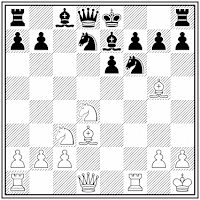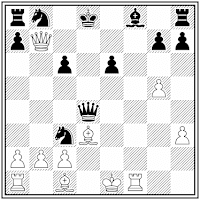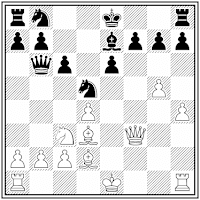I bought yesterday "Schachmatnyje Miniatjury", a Russian compilation of chessminiatures from 1978 for 1 €. A ridiculous price for such a great book,as it is filled with so many ideas to end the royal game before it is even started.
Obviously I looked for a game with our beloved gambit. The author indicates that "...the gambit is not completely correct and is found only very rarely in the current tournaments..." (translated from Russian). But I did find this magnificent correspondence game.
Zoller - Borsdorf, Germany, 1975
1.d4 d5 2.e4 dxe4 3.Nc3 Nf6 4.f3 Bf5
The author notes here that 4...exf3 is simpler and recommends 5.Nxf3 g6 6.Bc4 Bg7 )
5.fxe4 Nxe4 6.Nf3
6.Qf3 is the recommended move nowaday
6...e6 7.Bc4 Bb4 8.00 Bxc3
The author notes that blacks's latest move is not very wise and suggests 8...Nxc3 9.bxc3 Bxc3 10.Rb1 with "chances for both sides".
9.bxc3 Nxc3 10.Qe1 Ne4 11.Ba3 Nd7
11...Nd6 would have been much stronger, limiting the scope of white's black squared bishop.
12.d5 Qf6 13.dxe6 fxe6 14.Rad1 000 15.Nd4
My silicon friend gives black the advantage after 15...Ndc5, but black throws it all away with his next move.
15...Qg6 16.Nc6!!
first sacrifice
16...bxc6 17.Ba6+ Kb8 18.Rxd7!!
second
Ka8 19.Bb7+!!
third
Kxb7 20.Rxc7!!
fourth and last
Kxc7 21.Qa5+
1-0
What a game ! White offers 4 pieces in a row to remove the defense and open up lines. If there is a best-ever Blackmar Diemer, this would certainly be one of my favorites !
Saturday, May 28, 2011
Tuesday, May 24, 2011
An update on the refutation of the refutation !?
Last week, I covered Euwe's refutation of the Blackmar Diemer. The Dutch worldchampion played 6...c5 ( diagram ) after the opening moves 1.d4 d5 2.e4 exd4 3.Nc3 Nf6 4.f3 exf3 5.Nxf3 e6 6.Bg5 and believed it was the refutation of the Blackmar Diemer. But Diemer quickly replied with 7.Bxf6 and the continuation 7...Qxf6 8.Bb5+ Bd7 9.00 was believed to be much better for white.

For example, Scheerer gives only the short text "6...c5 is also premature as 7.Bxf6! Qxf6 8.Bb5+ Bd7 9.0-0 sees the queen in the firing line again...". Now you might know by now that I am not an enthusiast on this book - but here the auther seems to loose it completely as 9...cxd4 brings the defender again one pawn closer to a winning endgame, realising that white has no crushing win after both 10.Ne4 Qe7 or 10.Nxd4 Qe5 (=).
So what continuation is best ? I believe I found the answer, but white certainly does not have a crushing victory in sight, but following line offers white best chances for a win : 6...c5 7.Bxf6 Qxf6 8.Bb5+ Bd7 9.Ne5
Black has only 9...Bd6 to obtain equality, as other lines give white an easier game :
9...Qf4 10.Qe2 Bd6 11.Rf1 Qxh2 12.Nxd7 Qh4+ 13.Rf2 Qh1+ 14.Kd2 (+=)
9...Qh4+ 10.g3 Qxd4 11.Qe2 (++)
9...Bxb5 10.Nxb5
10...Qh4 11.g3 Qe4+ 12.Kf2 (+=)
10...Na6 11.Qe2 cxd4 12.Rf1 (++)
9...Bc6 10.Rf1 (++)
9...cxd4 10.Qxd4 Bxb5 11.Nxb5 Bb4+ 12.c3 (+=)
9...a6 10.Rf1 Qh4+ 11.g3 Qxd4 12.Qe2
12...Bxb5 13.Nxb5 Qb4+ ( 13...axb5 is answered by 14.c3 ) 14.Nc3 Nc6 15.000 (+=)
12...axb5 13.Rd1 (+-)
9...Nc6 10.Rf1 (+=)
9...Be7 10.Qe2 (+=)
Returning to the only black defense 9...Bd6 10.Rf1
A little help from our silicon friend indicates that 10...Qe7 11.Rxf7 Qh4+ 12.Rf2 (=) is black's only resource
If you are unfortunate enough that you opponent has found these moves behind the board, you might want to check out my next blog for details.

For example, Scheerer gives only the short text "6...c5 is also premature as 7.Bxf6! Qxf6 8.Bb5+ Bd7 9.0-0 sees the queen in the firing line again...". Now you might know by now that I am not an enthusiast on this book - but here the auther seems to loose it completely as 9...cxd4 brings the defender again one pawn closer to a winning endgame, realising that white has no crushing win after both 10.Ne4 Qe7 or 10.Nxd4 Qe5 (=).
So what continuation is best ? I believe I found the answer, but white certainly does not have a crushing victory in sight, but following line offers white best chances for a win : 6...c5 7.Bxf6 Qxf6 8.Bb5+ Bd7 9.Ne5
Black has only 9...Bd6 to obtain equality, as other lines give white an easier game :
9...Qf4 10.Qe2 Bd6 11.Rf1 Qxh2 12.Nxd7 Qh4+ 13.Rf2 Qh1+ 14.Kd2 (+=)
9...Qh4+ 10.g3 Qxd4 11.Qe2 (++)
9...Bxb5 10.Nxb5
10...Qh4 11.g3 Qe4+ 12.Kf2 (+=)
10...Na6 11.Qe2 cxd4 12.Rf1 (++)
9...Bc6 10.Rf1 (++)
9...cxd4 10.Qxd4 Bxb5 11.Nxb5 Bb4+ 12.c3 (+=)
9...a6 10.Rf1 Qh4+ 11.g3 Qxd4 12.Qe2
12...Bxb5 13.Nxb5 Qb4+ ( 13...axb5 is answered by 14.c3 ) 14.Nc3 Nc6 15.000 (+=)
12...axb5 13.Rd1 (+-)
9...Nc6 10.Rf1 (+=)
9...Be7 10.Qe2 (+=)
Returning to the only black defense 9...Bd6 10.Rf1
A little help from our silicon friend indicates that 10...Qe7 11.Rxf7 Qh4+ 12.Rf2 (=) is black's only resource
If you are unfortunate enough that you opponent has found these moves behind the board, you might want to check out my next blog for details.
Monday, May 16, 2011
A bit of a setback
Untill recently, I believed that Euwe's refutation of the Blackmar Diemer gambit was refuted. Indeed, Euwe suggested to counter white's centre quickly with a counterattack 6...c5 after the moves 1.d4 d5 2.e4 exd4 3.Nc3 Nf6 4.f3 exf3 5.Nxf3 e6 6.Bg5.
When I loaded this position in my chess computer recently, I saw - to my horror - that it gave equality after the traditional 8...Bd7 9.Ne5 Bd6 10.Rf1 Qe7 11.Rxf7 Qh4+ 12.Rf2 Bxe5 13.dxe5 Nc6 14.Qd6 000 15.Qxc5 Qxh2 ( diagram ) with only a minor advantage after 16.Ne4 Qg1+ 17.Bf1 Kb8
Also, the line 8...Nd7 9.00 cxd4 10.Ne4 Qf5 11.Bxd7+ Bxd7 12.Nfg5 Qe5 13.Nxf7 Qxe4 14.Nxh8 g6 15.Qd3 seems to bring not much for white.
This seems like a shock to me - is this really the refutation of the Blackmar Diemer gambit ? If we can't find any better continuation for white, then this line seems like a simple continuation for black - allowing him a comfortable draw. The defender just has to memorise this simple line and obtain a playable game. Or he could learn a more complicated defense ( like the Bogoljubow ) with potential winning chance. But this simple defense greatly reduces white's winning chances.
Please let me know your ideas on how to improve white's game.
Tuesday, May 10, 2011
Really that bad ?
The white continuation in the Euwe defense 6...Be7 7.Bd3 Nbd7 8.00 has been condemned because of black's energetic reply 8...c5!
White's thematic 9.Qe1 is useless because a/ black's has not castled yet and b/ white is wasting time recovering the pawn after 9...cxd4. Because of this continuation, 8.00 is often rejected as a feasible continuation. But can white not improve ? Let's have a closer look.
9.Qe1 cxd4 10.Ne4 ( concentrating on black's kingside instead of the timewasting 10.Nxd4 Qb6 11.Be3 and now black can start exchanging toards the endgame with 11...Ng4 ) and now there are various moves for a black advantage, such as 10...h6 or even 10...Qb6. So let's dismiss 9.Qe1 quickly.
9.Qe2 cxd4 10.Nxd4 ( 10.Ne4 is punished by 10...h6 or even 10...00 ) and now there are several black moves that give a small advantage to black ( eg 10...Qb6 or 10...Nc5 ). So it gets clear that 9.Qe2 wont bring anthing either - it is obviously better than 9.Qe1 but not enough for full equality.
So let's look ar 9.Kh1 - our last possible line before we burry 8.00 forever.
a/ 9...cxd4 10.Nxd4
a1/ 10...Nc5 11.Bb5+
a11/ 11...Bd7 12.Bxf6 Bxf6 13.Qh5 and black has only one move, eg 13...Rac8 14.Bxd7+
a12/ 11...Ncd7 and white has several moves ( Bxf6, Qe1 or Qf3 ) for equality
a13/ 11...Nfd7 12.Bxe7 and white wins
a2/ 10...h6 11.Nxe6!!! fxe6 12.Bg6+ Kf8 13.Qh5 with equality
White's thematic 9.Qe1 is useless because a/ black's has not castled yet and b/ white is wasting time recovering the pawn after 9...cxd4. Because of this continuation, 8.00 is often rejected as a feasible continuation. But can white not improve ? Let's have a closer look.
9.Qe1 cxd4 10.Ne4 ( concentrating on black's kingside instead of the timewasting 10.Nxd4 Qb6 11.Be3 and now black can start exchanging toards the endgame with 11...Ng4 ) and now there are various moves for a black advantage, such as 10...h6 or even 10...Qb6. So let's dismiss 9.Qe1 quickly.
9.Qe2 cxd4 10.Nxd4 ( 10.Ne4 is punished by 10...h6 or even 10...00 ) and now there are several black moves that give a small advantage to black ( eg 10...Qb6 or 10...Nc5 ). So it gets clear that 9.Qe2 wont bring anthing either - it is obviously better than 9.Qe1 but not enough for full equality.
So let's look ar 9.Kh1 - our last possible line before we burry 8.00 forever.
a/ 9...cxd4 10.Nxd4
a1/ 10...Nc5 11.Bb5+
a11/ 11...Bd7 12.Bxf6 Bxf6 13.Qh5 and black has only one move, eg 13...Rac8 14.Bxd7+
a12/ 11...Ncd7 and white has several moves ( Bxf6, Qe1 or Qf3 ) for equality
a13/ 11...Nfd7 12.Bxe7 and white wins
a2/ 10...h6 11.Nxe6!!! fxe6 12.Bg6+ Kf8 13.Qh5 with equality
a3/ 10...00 11.Qe1 transposing in the line b1 discussed below.
b/ 9...00 10.Qe1 (following the standard attacking lines)
b1/ 10...cxd4 11.Nxd4
b11/ 11...h6 12.Ne4!!!
b111/ 12...hxg5 13.Nxg5 equal
b112/ 12...Ng4 13.Bxe7 Qxe7 14.Qg3 equal
b113/ 12...Nd5 13.Bxe7 equal
b114/ 12...Ne5 13.Nxf6+ gxf6 14.Bxh6 equal
b115/ 12...Qb6 13.Nxf6+ Nxf6 14.Bxf6 Bxf6 15.Qe4 Rd8 16.Qh7+ small white advantage
b12/ 11...Nc5 12.Rd1 equal
b13/ 11...a6 12.Qh4 equal
b2/ 10...h6 11.Nxe6!!! transposing into line a2 above
b3/ 10...Re8 11.Qg3 equal
c/ 9...h6 10.Bh4
c1/ 10...00 11.Qe2 equal
c2/ 10...cxd4 11.Nxd4 equal
c3/ 10...Nd5 11.Nxd5 Bxh4 12.Nxh4 with white advantage
c4/ 10...Qc7 11.Nb5 equal
c5/ 10...Qb6 11.Qe2 equal
d/ 9...Nd5 10.Nxd5 with white advantage
e/ 9...a6 10.Qe1 equal
f/ 9...b6 10.Qe1 equal
So where is the black advantage after 8.00 c5 ? There is none - it seems to me that 9.Kh1 provides white an equal game. Agreed, white does not have the attacking prospects as in some other lines in the Euwe defense, but it seems white is certainly not lost. In addition, 8.00 allows black to go wrong by kingside castling.
Black's best line after 8.00 c5 9.Kh1 seems to be the quiet 9...h6 ( line c above ), with a Houdine assessment of 0.2 in black's favour.
So once again, don't believe everything the experts say ( that also goes for me... ), do your homework and keep on attacking that black king...
Thursday, May 5, 2011
An alternative plan
Let's look at the Teichmann Exchange lines after 1.d4 d5 2.e4 dxe4 3.Nc3 Nf6 4.f3 exf3 5.Nxf3 Bg4 6.h3 Bxf3 7.Qxf3 c6 8.g4 e6 9.g5 Nd5 10.Bd3 Nxc3
White's normal plan is now to play 11.bxc3, followed by kingside castling. But there is a another move, eg 11.Rf1 !!
Defending f7 might not be black's best choice, as the prefered 11...Qc7 is answered by 12.Bf4, further winning time and space.
11...Qe7 12.bxc3 Black has blocked his bishop, whilst white cant castle anymore - who is better ? Houdini gives white a small plus after 12...Nd7 13.Kd1
11...Qd7 12.bxc3 with equality, eg 12...Bd6 13.h4 00 14.h5 (equal) or 12...Na6 13.Bf4 (tiny white advantage) or 12...c5 13.Bb2 (white is better).
Black might be willing to take more risk and counterattack with 11...Qxd4 12.Qxf7+ Kd8 13.Qxb7
A very complicated position has occured :
13...Qe5+ 14.Kd2 Nd5 ( black's only chance for an advantage ) 15.Qxa8 Qc7 ( once again, the only chance for a plus ) 16.Ba6 with a small advantage to black. But then again, finding these moves over the board seems very, very unlikely...
13...Qh4+ 14.Kd2 Ne4+ 15.Kd1 Nf2+ 16.Ke2 equal.
13...Nd5 14.Qxa8 Qb6 15.Rf7 with small white advantage
13...Ne4 14.Qxa8 with white winning
13...Nb5 14.Qxa8 with white winning
And finally there is 11...f5 12.gxf6 Qxd4 13.bxc3 Qxc3 14.Ke2 equal, eg 14...Qxa1 15.Qe4
So white might clearly benefit from the preparation when playing 11.Rf1 - it provides an alternative for the 11.bxc3 lines.
In fact, 10...Nxc3 is condemned by theory, but 11.bxc3 Bd6 12.00 ( or 12.Rb1 ) offers only equality for white - so 11.Rf1 is not so bad as it might seem.
Tuesday, May 3, 2011
Black's difficult Teichmann Exchange defense
As we saw in previous posts, black can easily go wrong in the main lines of the Teichmann Exchange variation after 1.d4 d5 2.e4 dxe4 3.Nc3 Nf6 4.f3 exf3 5.Nxf3 Bg4 6.h3 Bxf3 7.Qxf3 c6 8.g4 e6 9.g5 Nd5 10.Bd3.
10...Bd6 was covered earlier and provides black only limited chances for equality, provided white chooses the right continuation 11.Ne4, and refrains from the natural 11.00
Black's main line 10...Be7 is followed by 11.h4 ( note that Scheerer gives 11.00 as the main line, without even mentioning 11.h4. Scheerer's continuation 11.00 00 12.Qe4 g6 13.h4 leads to disaster after both 13...c5 and 13...Qd6 - so once again, please dont follow the big books blindly !! )
a/ 11...00 looses immediately after 12.Qe4 g6 13.h5
a1/ 13...Bxg5 14.hxg6
a11/ 14...Bxc1 15.g7 !! Nf6 16.Qg2 winning
a12/ 14...hxg6 15.Qe5 !! winning
a2/ 13...Nxc3 14.bxc3 Qd5 15.Qh4 winning
a3/ 13...Nb4 14.hxg6 Nxd3 15.cxd3 winning
a4/ 13...Qe8 14.Qh4 f5 15.gxf6 winning
a5/ 13...Qc7 14.Qh4 winning
b/ 11...Nxc3 12.bxc3 only strengthens white d4 pawn
b1/ 12...00 13.Qe4 lines up the same idea as above
c2/ 12...exd5 13.Bd2 with small white advantage
d/ 11...Nb4 12.Bf4
d1/ 12...Nxd3+ 13.Qxd3 equal
d2/ 12...Qxd4 13.000 with small white advantage
d3/ 12...Qa5 13.a3 equal
d4/ 12...Na6 13.Be4 equal
e/ 11...Qb6 12.Bd2
10...Bd6 was covered earlier and provides black only limited chances for equality, provided white chooses the right continuation 11.Ne4, and refrains from the natural 11.00
Black's main line 10...Be7 is followed by 11.h4 ( note that Scheerer gives 11.00 as the main line, without even mentioning 11.h4. Scheerer's continuation 11.00 00 12.Qe4 g6 13.h4 leads to disaster after both 13...c5 and 13...Qd6 - so once again, please dont follow the big books blindly !! )
a/ 11...00 looses immediately after 12.Qe4 g6 13.h5
a1/ 13...Bxg5 14.hxg6
a11/ 14...Bxc1 15.g7 !! Nf6 16.Qg2 winning
a12/ 14...hxg6 15.Qe5 !! winning
a2/ 13...Nxc3 14.bxc3 Qd5 15.Qh4 winning
a3/ 13...Nb4 14.hxg6 Nxd3 15.cxd3 winning
a4/ 13...Qe8 14.Qh4 f5 15.gxf6 winning
a5/ 13...Qc7 14.Qh4 winning
b/ 11...Nxc3 12.bxc3 only strengthens white d4 pawn
b1/ 12...00 13.Qe4 lines up the same idea as above
b2/ 12...Nd7 13.00 00 14.Rb1 with an equal position
b3/ 12...Qd5 13.Be4 Qc4 14.Rb1 b6 15.Rb3 with a small white advantage
b4/ 12...Qc7 13.00 00 14.Rb1 with a small white advantage
b5/ 12...Qb6 13.00 00 14.Qe4 g6 15.h5 with a small white advantage
d/ 11...Nb4 12.Bf4
d1/ 12...Nxd3+ 13.Qxd3 equal
d2/ 12...Qxd4 13.000 with small white advantage
d3/ 12...Qa5 13.a3 equal
d4/ 12...Na6 13.Be4 equal
e/ 11...Qb6 12.Bd2
e1/ 12...Qxd4 13.Nxd5 Qxd5 14.Be4 Qc4 15.000 equal - white has a tremendous developm,ent and space advantage for the two sacrificed pawns
e2/ 12...Nd7 13.Nxd5 equal ( probably better than 13.Ne2 that I recommended in my book )
e3/ 12...00 13.Qe4 g6 14.h5 and white is clearly winning
e4/ 12...Qxb2 13.Rb1 Qa3 14.00 and white is better
e5/ 12...Nxc3 13.Bxc3 and a tiny white advantage
f/ 11...Qc7 12.Bd2
f1/ 12...Nd7 13.000 and a small white advantage
f2/ 12...Na6 13.Nxd5 and white is better
f3/ 12...Nxc3 13.Bxc3 and white is better
f4/ 12...00 13.000 and white is better
g/ 11...Qa5 12.Bd2
g1/ 12...Nxc3 13.Bxc3 Bb4 14.Bxb4 Qxb4 15.c3 and white is better
g2/ 12...Nd7 13.Ne2 and white is better
g3/ 12...Bb4 13.a3 Bxc3 14.bxc3 and white is clearly better
g4/ 12...00 13.Qe4 ( better than 13.a3 as recommended in my book ) g6 14.h5 Nxc3 15.bxc3 with a large white advantage
So let's look back and consider black's chances. Black is a pawn ahead in all lines, but his position remains underdeveloped, crampled by the advanced h4 and g5 pawns. White will simply castle queenside and must wait untill black makes a mistake.
After black castling kingside, white's thematic attack Qe4 followed by h5 is exceptionally strong and sufficient for the win.
Summary, black can obtain equality in the main Teichmann Exchange lines ( 1.d4 d5 2.e4 dxe4 3.Nc3 Nf6 4.f3 exf3 5.Nxf3 Bg4 6.h3 Bxf3 7.Qxf3 c6 8.g4 e6 9.g5 Nd5 10.Bd3 Be7 11.h4 ), but it is an uphill struggle and provides no room for a black win against accurate white play.
Subscribe to:
Comments (Atom)




















